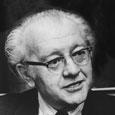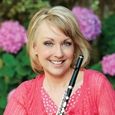Most of us started playing piccolo in school band programs, so it naturally follows that some of the finest piccolo parts are found in the band repertoire.
Karel Husa’s Music for Prague 1968 is a powerful programmatic composition that was written for wind ensemble and transcribed for orchestra later, in 1970. Commissioned by Ithaca College, the Ithaca College Wind Ensemble presented a commemorative concert on October 13, 2009 to honor the 40th anniversary of the premiere of this piece. Since the first performance, this work has become one of the most performed wind ensemble pieces around the world.
 Karel Husa was born in Prague in 1921. His main musical training took place at the Prague Conservatoire, as well as at the Conservatoire de Musique de Paris, where he studied composition with Nadia Boulanger and Arthur Honegger and conducting with Jean Fournet, Eugene Bigot, and Andre Cluytens. Compositions for symphonic band figure prominently among his works, as he saw the ensemble as artistically equal to a symphony orchestra. Indeed, he seemed to entrust several of his most important artistic messages to works he wrote for wind band.
Karel Husa was born in Prague in 1921. His main musical training took place at the Prague Conservatoire, as well as at the Conservatoire de Musique de Paris, where he studied composition with Nadia Boulanger and Arthur Honegger and conducting with Jean Fournet, Eugene Bigot, and Andre Cluytens. Compositions for symphonic band figure prominently among his works, as he saw the ensemble as artistically equal to a symphony orchestra. Indeed, he seemed to entrust several of his most important artistic messages to works he wrote for wind band.
Music for Prague 1968 is scored for piccolo (a divisi part, so two players must be used) and flutes 1 and 2. The 23-minute long work is written in four movements: I. Introduction and Fanfare, II Aria, III Interlude (scored only for percussion), and IV. Toccata and Chorale.
On August 20, 1968, troops from the Soviet Union and its allies invaded Czechoslovakia. Husa, who was living in America at the time, was deeply moved by the sad news as he listened on his radio. He knew the invasion would have an immediate impact on family members still living in Prague. He began sketches for the piece and completed it in seven weeks.
There is great use of symbolism in the work. The lengthy piccolo bird call solo in the opening is the symbol of liberty, something that the City of Prague has seen only for moments during it’s thousand years of existence. Husa provides the following program notes:
Three main ideas bind the composition together. The first and most important is an old Hussite war song from the 11th century, “Ye Warriors of God and His Law,” a symbol of resistance and hope for hundreds of years, whenever fate lay heavy on the Czech nation. It has been utilized also by many Czech composers, including Smetana in My Country. The beginning of this religious song is announced very softly in the first movement by the timpani and concludes in the strong unison (“Chorale”). The song is never used in its entirety.
The second idea is the sound of bells throughout: Prague, named also the “City of Hundreds of Towers,” has used its magnificently sounding church bells throughout history as calls of distress as well as of victory.
The last idea is a motif of three chords first appearing very softly under the piccolo solo at the beginning of the piece, in flutes, clarinets and horns. Later it reappears at extremely strong dynamic levels, for example, in the middle of the Aria.
The piece opens with a bar of timpani solo, and then the piccolo solo begins. Because there is chordal accompaniment under this opening solo, little rhythmic freedom can be taken. The long sustained pitches must be held all the way through. Be sure to budget the airstream carefully for the first long G, which is 7 1/2 beats long. You can remove the vibrato towards the end of the dimuendo.

Connect the ideas in measures four and five over the eighth rest at the end of measure four, as this idea is all one phrase. The group of five notes in the fifth measure can move ahead with a bit more energy. 
Keep true to the legato markings on the triplet in measure six and again, phrase all the way through toFrom this point in the solo, build the energy so that the phrase peaks at the first trill key on the D# to keep the pitch up. Alternately, you can finger this note all the way thruough without the first finger of the left hand (T234 1234).
.jpg)
From this point in the solo, build the energy so that the phrase peaks at the sforzando in measure 11. It is important to observe all of the marked breaths throughout the solo.
The first movement also closes with a short piccolo solo:

I use the fingering 23 234 for the long C# at the end of the work for added control and pitch stability.
This work is a classic that symbolizes the triumph of the human spirit over adversity. Husa conducted the Czechoslavakian premiere of Music for Prague 1968 on February 13, 1990 in Prague’s Smetana Hall. The performance aired nationwide on radio and television. This marked the composer’s return to Prague’s concert life after more than 40 years in exile and is a testament to the importance of this work in Husa’s life.






